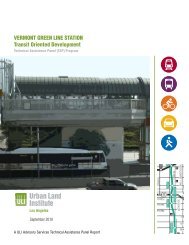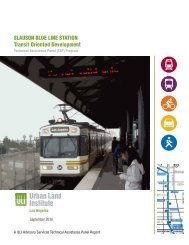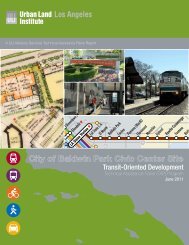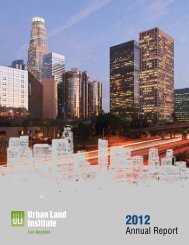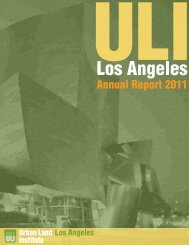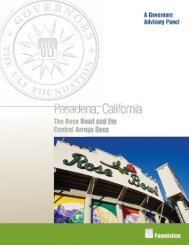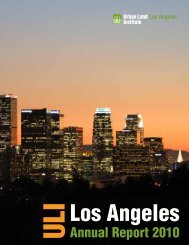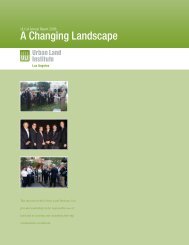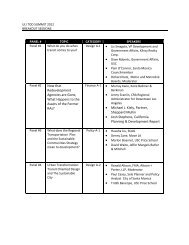Jordan Downs - ULI Los Angeles - Urban Land Institute
Jordan Downs - ULI Los Angeles - Urban Land Institute
Jordan Downs - ULI Los Angeles - Urban Land Institute
You also want an ePaper? Increase the reach of your titles
YUMPU automatically turns print PDFs into web optimized ePapers that Google loves.
<strong>Jordan</strong> <strong>Downs</strong> 103rd Street Blue Line Station<br />
Transit Oriented Development<br />
Technical Assistance Panel (TAP) Program<br />
October 2010<br />
A <strong>ULI</strong> Advisory Services Technical Assistance Panel Report
About the <strong>ULI</strong> <strong>Los</strong> <strong>Angeles</strong> Technical Assistance Panel<br />
In keeping with the <strong>Urban</strong> <strong>Land</strong> <strong>Institute</strong> mission, Technical Assistance Panels are convened to provide pro-bono<br />
planning and development assistance to public officials and local stakeholders of communities and nonprofit<br />
organizations who have requested assistance in addressing their land use challenges.<br />
A group of diverse professionals representing the full spectrum of land use and real estate disciplines typically<br />
spend one day visiting and analyzing the built environments, identifying specific planning and development<br />
issues, and formulating realistic and actionable recommendations to move initiatives forward in a fashion<br />
consistent with the applicant’s goals and objectives.<br />
Staff and Panel Members<br />
TAP Client<br />
Housing Authority of the City of <strong>Los</strong> <strong>Angeles</strong> (HACLA)<br />
Panel Chair<br />
Tunua Thrash<br />
Director, Green Door Advisors<br />
Panelists<br />
Amy Bodek<br />
Executive Director, City of Long Beach Redevelopment<br />
Agency<br />
Vanessa Delgado<br />
Director of Development – West Coast, Primestor<br />
Amelia Doyle, AIA, LEED AP, Associate Cuningham<br />
Architecture Group<br />
Daniel Gehman<br />
Principal, TCA Architects<br />
Ayalushim Hammond<br />
Senior Vice President, Thomas Properties Group<br />
David Hitchcock<br />
Partner, H&H LLP<br />
Sandra Kulli<br />
President, Kulli Marketing<br />
Gerard McCallum<br />
Project Manager, Wilson Meany Sullivan<br />
Rob Zirkle<br />
Associate Principal, Steinberg<br />
TAP Committee Chair<br />
Jonathan Curtis<br />
Principal, Trevear Holdings LLC<br />
TOD Summit TAP Advisor<br />
Robert Gardner<br />
Managing Director, RCLCO<br />
<strong>ULI</strong> Project Staff<br />
Katherine Perez<br />
Executive Director, <strong>ULI</strong> <strong>Los</strong> <strong>Angeles</strong><br />
Christine Aure<br />
Project Manager, <strong>ULI</strong> <strong>Los</strong> <strong>Angeles</strong><br />
Ciara Contreras<br />
Project Manager, <strong>ULI</strong> <strong>Los</strong> <strong>Angeles</strong><br />
Stephen Sampson<br />
Intern, <strong>ULI</strong> <strong>Los</strong> <strong>Angeles</strong><br />
John Dlugolecki<br />
Photographer
Table of<br />
Contents<br />
Executive Summary 2<br />
Assignment & Process 4<br />
Background 6<br />
Findings 8<br />
Recommendations 9<br />
Funding Sources 12<br />
Acknowledgements 13<br />
Panel Members 14<br />
1
Executive<br />
Summary<br />
2 <strong>Jordan</strong> <strong>Downs</strong>/103rd Street Blue Line Station Transit Oriented Development Technical Assistance Panel Program<br />
The Housing Authority of the City of <strong>Los</strong> <strong>Angeles</strong> (HACLA) has<br />
embarked on an impressive journey to redevelop the <strong>Jordan</strong> <strong>Downs</strong><br />
Public Housing site in Watts to create a vibrant urban village to<br />
transform the lives of its residents. A critical component of a thriving<br />
urban community is strong transportation connections. To enhance<br />
public transportation linkages, especially to the nearby Kenneth<br />
Hahn/103rd Street Metro Blue Line Station (103rd Street Station),<br />
the Housing Authority engaged the <strong>Urban</strong> <strong>Land</strong> <strong>Institute</strong> <strong>Los</strong> <strong>Angeles</strong><br />
District Council (<strong>ULI</strong> <strong>Los</strong> <strong>Angeles</strong>) to provide strategic directions and<br />
recommendations.<br />
<strong>ULI</strong> <strong>Los</strong> <strong>Angeles</strong> assembled industry experts in a Technical<br />
Assistance Panel (TAP) beginning on April 22, 2010, utilizing experts<br />
in architecture, planning, development, and market economics to<br />
determine the main challenges and opportunities, offer solutions, and<br />
develop a roadmap for success for <strong>Jordan</strong> <strong>Downs</strong> and the 103rd Street<br />
Blue Line Station.<br />
The TAP evaluated the area within a half mile radius around the 103rd<br />
Street Station, encompassing the <strong>Jordan</strong> <strong>Downs</strong> community and<br />
found numerous opportunities and challenges. The station connects<br />
the neighborhood to major job centers, academic institutions, and<br />
regional destinations such as downtown <strong>Los</strong> <strong>Angeles</strong> to the north
and downtown Long Beach to the south, and the TAP found that HACLA’s<br />
planning process has engaged community stakeholders to have a vested<br />
interest in the area’s improvement. However, the perceived lack of safety<br />
to the station, lack of financial resources, and leadership turnover are<br />
tremendous challenges for the Station’s success and the community’s<br />
revitalization around it.<br />
The TAP members believe improving the transit station and the pedestrian<br />
connections, in addition to key opportunities on Century Boulevard and<br />
Alameda Corridor will contribute to the <strong>Jordan</strong> <strong>Downs</strong> community’s vision<br />
for a vibrant and sustainable urban village.<br />
The TAP’s vision for the enhanced <strong>Jordan</strong> <strong>Downs</strong> Station includes the<br />
following concepts:<br />
• The Century begins in <strong>Jordan</strong> <strong>Downs</strong><br />
• Once in a Century Opportunity<br />
• Re-envisioning 103rd Street/Station: Applying 21st Century principles<br />
of transit-oriented development<br />
3
The Housing Authority has plans for a redevelopment of <strong>Jordan</strong> <strong>Downs</strong> and the panelists were tasked to look at this plan’s relationship to the 103rd Street Blue Line<br />
Assignment & Process<br />
Key Issues<br />
<strong>ULI</strong> <strong>Los</strong> <strong>Angeles</strong> assembled industry experts in a<br />
Technical Assistance Panel (TAP) to advise HACLA and<br />
the City of <strong>Los</strong> <strong>Angeles</strong> on the following key areas:<br />
• What are the appropriate commercial development<br />
(retail/office) opportunities for the Century<br />
Boulevard right-of-way extension? Given the<br />
desired commercial development for the Century<br />
Boulevard right-of-way extension, what steps<br />
should the HACLA take to create interior-circulation<br />
for the redeveloped site based on the HACLA Master<br />
Plan?<br />
• What specific urban design and infrastructure<br />
improvements concerning the 103rd Street Station<br />
itself should be considered to improve access and<br />
safety, thus leading to the creation of a more highlyvalued<br />
community asset?<br />
• What public and private sector improvements can<br />
be made along 103rd Street, the key street linking<br />
<strong>Jordan</strong> <strong>Downs</strong> to the 103rd Street Station? The goal<br />
here would be a seamless connection that enhances<br />
<strong>Jordan</strong> <strong>Downs</strong>’ transit orientation.<br />
4 <strong>Jordan</strong> <strong>Downs</strong>/103rd Street Blue Line Station Transit Oriented Development Technical Assistance Panel Program<br />
• What employment opportunities exist and can be<br />
created on the property contiguous to <strong>Jordan</strong> <strong>Downs</strong><br />
and along the Alameda Corridor? Assuming that<br />
this land comes with a low cost basis, what unique<br />
opportunities, e.g., incubators, etc., should be<br />
considered?<br />
• Recommend next steps the HACLA should take to<br />
meet its goals for a transit oriented community and<br />
offer strategies to secure additional funding.<br />
Considerations<br />
An enhanced transit station and access will further<br />
HACLA’s goals to create interconnectivity between<br />
the <strong>Jordan</strong> <strong>Downs</strong> site and the 103rd Street blue line<br />
metro rail, the green line, MLK Hospital, Charles Drew<br />
University, downtown, the airport, and LA Port.<br />
The first afternoon begins with a detailed tour through <strong>Jordan</strong> <strong>Downs</strong>
TAP Process<br />
<strong>ULI</strong> representatives met with representatives<br />
from the Department of Regional Planning to<br />
determine the scope of the panel assignment.<br />
The panel members were selected based upon<br />
their ability to address the stated objectives for<br />
the program provided by the client. Prior to the<br />
day-long program, panel members reviewed<br />
background materials prepared by the Housing<br />
Authority of the City of <strong>Los</strong> <strong>Angeles</strong>.<br />
Panelists embark on a site tour to familiarize themselves with<br />
the area<br />
The TAP process is a day and a half long<br />
event. The first afternoon included a site<br />
tour of the <strong>Jordan</strong> <strong>Downs</strong> Community with<br />
HACLA representatives and interviews with<br />
key stakeholders. The second day began with<br />
continued stakeholder interviews and then<br />
proceeded with an intensive analysis on the<br />
specified issues, and present their findings to<br />
the general public.<br />
The southwest corner of the study area is home to community<br />
garden<br />
A primary focus of the panel was looking at pedestrian friendly linkages between <strong>Jordan</strong> <strong>Downs</strong> and the 103rd<br />
street station<br />
TAP Panel of Experts<br />
<strong>ULI</strong> <strong>Los</strong> <strong>Angeles</strong> representatives met with representatives from HACLA to determine the<br />
scope of the panel assignment. Members were selected with the intent of convening<br />
a robust array of professional expertise relevant to HACLA’s objectives for the study<br />
and who had local working knowledge of the sub-region where the study site was<br />
located. Together their expertise represented a variety of disciplines connected with<br />
land use and real estate development, including architecture, planning, development,<br />
redevelopment and market economics. All panel members were volunteers and were<br />
not compensated for their time.<br />
Panelists listen as HACLA Development Department Director, Larry Goins, explains the history of the site<br />
5
Compton Ave<br />
Century Blvd<br />
Context<br />
The Housing Authority of the City of <strong>Los</strong> <strong>Angeles</strong> (HACLA), working with the Mayor’s<br />
office and a broad spectrum of City departments, and building off the support of the<br />
<strong>Jordan</strong> <strong>Downs</strong> community leadership, have conceived a bold vision for the <strong>Jordan</strong><br />
<strong>Downs</strong> community as a “vibrant urban village that offers quality housing, access to<br />
quality community amenities, transit connections to the 103rd Street rail stop and a<br />
built environment that encompasses all the components of a sustainable community.”<br />
<strong>Jordan</strong> <strong>Downs</strong>/ 103rd<br />
Street Station Study Area<br />
E 103rd Street<br />
103rd Street Blue<br />
Line Station<br />
Wilmington Ave<br />
<strong>Jordan</strong> <strong>Downs</strong><br />
Public Housing<br />
Half mile radius for the 103rd Street Station Blue Line Station<br />
Background<br />
Regional location of <strong>Jordan</strong> <strong>Downs</strong>/103rd Street Blue Line Station study area<br />
6 <strong>Jordan</strong> <strong>Downs</strong>/103rd Street Blue Line Station Transit Oriented Development Technical Assistance Panel Program<br />
Alameda<br />
Rider have to cross a set of tracks upon entering or exiting the station<br />
Panelists Rob Zirkle and Daniel Gehman talk with area residents<br />
The redevelopment of <strong>Jordan</strong> <strong>Downs</strong> presents a<br />
tremendous opportunity to transform not only <strong>Jordan</strong><br />
<strong>Downs</strong> but serves as the catalyst for economic<br />
revitalization in Watts. A community master plan has<br />
been completed and work on a specific plan has begun<br />
to formalize the master plan. Under the plan, HACLA<br />
intends to replace of the 700 existing public housing<br />
units, and an additional 900 - 1,100 affordable and<br />
market rate housing, a family resource center, new<br />
amenities, and a new pattern of streets that will improve<br />
connections with the surrounding Watts Community.<br />
The redevelopment plan is a model of sustainability<br />
and HACLA was recently awarded a SCAG Compass<br />
Blueprint Demonstration award.<br />
About the 103rd Street/Kenneth Hahn Metro Blue<br />
Line Station<br />
The 103rd Street/Kenneth Hahn Metro Blue Line Station<br />
is located in the center of the Watts neighborhood in<br />
South <strong>Los</strong> <strong>Angeles</strong> at the intersection of 103rd Street and<br />
Graham Avenue. The station is located in the City of <strong>Los</strong><br />
<strong>Angeles</strong> and within the CRA/LA Watts Corridor Project<br />
Area. The station offers linkages to the region with its<br />
central location and accessibility to the 105 freeway,<br />
the Alameda Corridor, DASH and Metro bus lines. The<br />
current station is directly northwest of the Watts Towers.
About the <strong>Jordan</strong> <strong>Downs</strong> Community<br />
The <strong>Jordan</strong> <strong>Downs</strong> community is centrally located<br />
in <strong>Los</strong> <strong>Angeles</strong>, sits next to the Alameda corridor, is<br />
approximately one-quarter of a mile away from the<br />
Metro Green Line station at 103rd Street, and will<br />
be reconnected to Century Boulevard leading to <strong>Los</strong><br />
<strong>Angeles</strong> International Airport to the West and the City of<br />
South Gate to the East.<br />
The <strong>Jordan</strong> <strong>Downs</strong> public housing development is<br />
bounded by Grape Street to the west, 97th Street to<br />
the north, Alameda to the east and 103rd Street to the<br />
south.<br />
A map of the bus lines serving the area, including 6 Metro Bus Lines 55, 108,110<br />
358 611<br />
Diagram Illustrating the walk times from <strong>Jordan</strong> <strong>Downs</strong>. The 103rd Street Blue Line Station is about a 10 minute walk from <strong>Jordan</strong> <strong>Downs</strong><br />
7
The Cultural Crescent is a strength within the study area for its value as a community asset<br />
Findings<br />
A Strengths, Weaknesses, Opportunities, and Threats (SWOT) analysis was conducted<br />
to evaluate the <strong>Jordan</strong> <strong>Downs</strong> and the 103rd Street Blue Line Station. Strengths and<br />
weaknesses explore internal aspects of the project or elements that can be controlled<br />
or changed by new development. Opportunities and threats evaluate external influences<br />
that can affect the project. From the site visit, stakeholder interviews, and additional<br />
site research, the TAP determined the following strengths, weaknesses, opportunities<br />
and threats for the <strong>Jordan</strong> <strong>Downs</strong> Station TOD study area.<br />
Strengths<br />
– Strong entrepreneurial spirit<br />
– Nearby Colleges and employment centers<br />
– Community eagerness to promote change<br />
– Strong cultural pride & tradition<br />
– HACLA has a strong relationship with the community<br />
– Existing cultural assets – “Cultural Crescent”<br />
Weaknesses<br />
– Negative stigma associated with “Watts”<br />
– Need for additional Latino representation<br />
– Lack of financial resources<br />
– Leadership turnover in regulatory entities<br />
– Perceived lack of safety<br />
– DWP park plaza station use is by appointment only<br />
8 <strong>Jordan</strong> <strong>Downs</strong>/103rd Street Blue Line Station Transit Oriented Development Technical Assistance Panel Program<br />
A weakness is that the DWP Plaza is open by appointment only<br />
The quantity and location of available land provide opportunity<br />
Opportunities<br />
– <strong>Land</strong> availability<br />
– Connection with transit (dash,<br />
community college, workforce centers,<br />
etc)<br />
– Community support of the development<br />
master plan<br />
– Educational Opportunities- broaden<br />
educational career options<br />
– Proximity to transit<br />
– Specific plan provides opportunity to<br />
define land use<br />
Threats<br />
– Bureaucratic inertia<br />
– Possibility of momentum loss<br />
– Lack of funding and inter-agency<br />
coordination<br />
– Leadership turnover (LAPD, CRA/LA,<br />
Planning Department, etc.)<br />
– “Fear changes the thought process and<br />
therefore actions”
The Existing Street Section Along Century Boulevard<br />
The panel’s proposed street section at Century Boulevard<br />
Section enlargement of the sidewalk condition along Century Boulevard<br />
Recommendations<br />
Vision<br />
The TAP members believe improving the transit station and the pedestrian<br />
connections, in addition to key opportunities on Century Boulevard and Alameda<br />
Corridor will contribute to the <strong>Jordan</strong> <strong>Downs</strong> community’s vision for a vibrant and<br />
sustainable urban village.<br />
Vision Strategies<br />
The TAP’s vision for the enhanced <strong>Jordan</strong> <strong>Downs</strong> Station includes:<br />
I– The Century begins in <strong>Jordan</strong> <strong>Downs</strong><br />
II – Once in a Century Opportunity<br />
III – Re-envisioning 103rd Street/Station: Applying 21st Century principles of<br />
transit-oriented development<br />
Vision Strategy I: The Century Begins in <strong>Jordan</strong> <strong>Downs</strong><br />
The extension of Century Boulevard to Alameda Corridor has the potential to serve<br />
as the beginning of Century Boulevard with a main street character. The panel<br />
recommends attracting pedestrian-oriented uses including an ATM, social services,<br />
dry-cleaner, outdoor dining, and a fitness component. These neighborhood elements<br />
would allow for more eyes on the community to improve the perception of safety.<br />
The design of Century Boulevard should provide for a strong neighborhood identity<br />
with a widened sidewalk, decorative sidewalk lighting, two rows of trees and storefront<br />
awnings.<br />
The panel recommends highlighting Century Boulevard through the <strong>Jordan</strong> <strong>Downs</strong> redevelopment<br />
9
Vision Strategy I: Implementation Steps<br />
YEAR 1<br />
– Establish a Streetscape Plan<br />
– Develop a supplemental use district.<br />
YEAR 3<br />
– Conduct assessment and market study<br />
- Identify neighborhood retail/community based entities<br />
- Hire <strong>Land</strong>scape Architect and Civil Engineer;<br />
- Gain consensus with community for design of project.<br />
YEAR 5<br />
– Recruit tenants for social service and retail<br />
– Develop maintenance plan for park, median and other open spaces;<br />
– Develop community programs for open spaces, such as farmers market, festivals<br />
and other celebrations.<br />
Vision Strategy II: Once in a Century Opportunity<br />
The land along the Alameda corridor is a unique opportunity to generate high-quality<br />
jobs for residents. The panel suggests light industrial along the corridor with some<br />
space for job training and employment centers.<br />
Vision Strategy II: Implementation Steps<br />
YEAR 1<br />
– Focus on job generation, not just numbers but quality and skill level<br />
– Remain flexible with land use to respond to market conditions<br />
– Coordinate land use with nearby employment training centers<br />
– Utilize light industrial as a catalyst for incubators, job training and skill paths<br />
– The ultimate land uses should be thought of as a career path not just a wage<br />
YEARS 3-5<br />
– Implement site development.<br />
10 <strong>Jordan</strong> <strong>Downs</strong>/103rd Street Blue Line Station Transit Oriented Development Technical Assistance Panel Program<br />
The panel suggests a gateway element at the intersection of Alameda & Century<br />
At the western end a community garden gateway is proposed
Vision Strategy III: Re-envisioning 103rd Street/<br />
Station - Applying 21st Century principles of<br />
transit-oriented development<br />
The panel proposes HACLA work with Metro and<br />
partners at the CRA/LA and the City to enhance the<br />
103rd Street/Kenneth Hahn Station and 103rd Street<br />
as a connection between <strong>Jordan</strong> <strong>Downs</strong> and the rail<br />
station.<br />
At the station, the panel recommends the following<br />
interventions:<br />
- Implement physical interventions to enhance<br />
safety including surveillance in the short-term<br />
for the parking lot and pedestrian connections on<br />
103rd Street.<br />
- Allow for access to the CRA/LA DPW Plaza<br />
- Aesthetic enhancements to the station platform<br />
- Implement wayfinding signage<br />
- Incorporate public art<br />
- Create “sharrows” for bike lanes to the station<br />
and create a bike station at the historic train<br />
station and café<br />
For 103rd Street, the panel recommends:<br />
- Aesthetic enhancements<br />
- Façade programs/signage program<br />
- Create a gateway for <strong>Jordan</strong> <strong>Downs</strong> at the<br />
community garden at the intersection of 103rd<br />
Street and Grape.<br />
- Banners<br />
- Streetlights<br />
- Bus shelters<br />
- Wayfinding<br />
- Enhanced crosswalks with decorative paving and<br />
flashing crossings.<br />
Vision Strategy III: Implementation Steps<br />
YEAR 1 - immediately<br />
– Seek MTA Call for Projects for Bike Station; Way-finding<br />
– MTA Capital Improvement Projects funding for station improvements and safety<br />
improvements.<br />
YEAR 1 – near term<br />
– Take down fence at DWP plaza<br />
– License kiosks for coffee, muffins, etc.<br />
– Kiosk for train tickets, etc.<br />
– Encourage MTA to assess and implement safety protocols<br />
– Encourage MTA to landscape areas adjacent to station<br />
YEAR 5 – long term<br />
– Aesthetic Enhancements (façade program/signage program, banners, streetlights<br />
(LED), bus shelters, Wayfinding, enhanced crosswalks with decorative paving<br />
and flashing pedestrian crossings)<br />
11
Funding Sources<br />
The Watts Towers are a cultural icon that the communinty identifies with<br />
12 <strong>Jordan</strong> <strong>Downs</strong>/103rd Street Blue Line Station Transit Oriented Development Technical Assistance Panel Program<br />
Funding Sources<br />
There are numerous funding sources available to the<br />
Housing Authority and other agencies for enhancements<br />
to the transit station and the surrounding areas. Due to<br />
time constraints of the one day panel format, greater<br />
detail and focus on the funding sources was not included<br />
in the scope of the assignment. Strategies to attain and<br />
utilize these revenue streams will be highlighted in a<br />
forthcoming report from <strong>ULI</strong> <strong>Los</strong> <strong>Angeles</strong>.<br />
Below is a short list of sources that the Housing<br />
Authority should explore:<br />
• Metro Call for Projects<br />
• County General Fund Capital Projects<br />
• County CDBG Funds<br />
• Revenue Bonds<br />
• Certificates of Participation<br />
• Assessment District<br />
• New Market Tax Credits<br />
• Other Federal Funds<br />
• Other State Funds<br />
• Foundation Funding<br />
• Private Bank Financing<br />
• County Loan Programs<br />
• County Business Loan Program<br />
• County Development Loan Program<br />
• County Business Expansion Loan Program<br />
• County Float Loan Program<br />
• County Technology Loan Program<br />
• County Section 108 Loan Program
Acknowledgements<br />
The TAP wishes to thank the Housing Authority<br />
of the City of <strong>Los</strong> <strong>Angeles</strong> including Rudy<br />
Montiel, CEO; John King II, Director, Planning<br />
and Policy Development; Jennifer Thomas<br />
Arthurs, Community Development Manager; and<br />
Belle Gomez, Community Development Project<br />
Manager for their commitment and support for<br />
the preparation of this report. The TAP is also<br />
thankful for the participation of the following<br />
stakeholders and community members:<br />
• Charlotte Brimmer, Project Manager,<br />
CRA/LA Watts Area<br />
• Michael Banner, President & CEO,<br />
<strong>Los</strong> <strong>Angeles</strong> LDC<br />
• Chris R. <strong>Jordan</strong>, Executive Director,<br />
Grant Housing & Economic<br />
Development Corporation<br />
• Steven Chen, Senior Engineer, Bureau<br />
of Engineering<br />
• Aaron Anderson, CBRE<br />
• Seth Polen, Keller Williams and 915<br />
Mateo<br />
• Irv Taylor, Metro<br />
• John P. Creer, Director, Facilities<br />
Services Division, <strong>Los</strong> <strong>Angeles</strong> Unified<br />
School District<br />
• Betty Day, Watts Gang Task Force<br />
• Jacquline Ellis-Trice, <strong>Jordan</strong> <strong>Downs</strong><br />
Community Member<br />
• Keyon Johnson, Community<br />
Representative<br />
• Barbara Stanton, Watts Star Theater<br />
• Bill Price<br />
• Daniel Fausto, CAC Youth<br />
Representative<br />
Acknowledgements<br />
TAP members appreciate insights shared by HACLA staff & community members to better understanding the issues<br />
13
Panel Members<br />
Panel Chair<br />
Tunua Thrash<br />
Director, Green Door Advisors<br />
Ms. Thrash is the Director of Green Door Advisors<br />
Panel Members<br />
Amy Bodek<br />
Executive Director, City of Long Beach Redevelopment Agency<br />
Ms. Bodek is the Executive Director of the City of Long Beach<br />
Redevelopment Agency<br />
Vanessa Delgado<br />
Director of Development – West Coast, Primestor<br />
Ms. Delgado is the Director of West Coast Development for Primestor<br />
Amelia Doyle, AIA, LEED AP<br />
Associate Cuningham Architecture Group<br />
Daniel Gehman<br />
Principal, TCA Architects<br />
Ayalushim Hammond<br />
Senior Vice President, Thomas Properties Group<br />
David Hitchcock<br />
Partner, H&H LLP<br />
Sandra Kulli<br />
President, Kulli Marketing<br />
Gerard McCallum<br />
Project Manager, Wilson Meany Sullivan<br />
Rob Zirkle<br />
Associate Principal, Steinberg<br />
14 <strong>Jordan</strong> <strong>Downs</strong>/103rd Street Blue Line Station Transit Oriented Development Technical Assistance Panel Program
Panel Members<br />
TAP Panelists (left to right) - Sandra Kulli, Gerard McCallum, Amy Bodek, Rob Zirkle, Daniel<br />
Gehman, Amelia Doyle, David Hitchcock, Tunua Thrash, Vanessa Delgado, Ayalushim Hammond<br />
15
At the <strong>Urban</strong> <strong>Land</strong> <strong>Institute</strong>, our mission is to provide leadership in the responsible use<br />
of land and in creating and sustaining thriving communities worldwide.<br />
601 S. Figueroa, Suite 500<br />
<strong>Los</strong> <strong>Angeles</strong>, CA 90017<br />
213-542-4694<br />
www.uli-la.org<br />
<strong>ULI</strong> <strong>Los</strong> <strong>Angeles</strong>, a district council of the <strong>Urban</strong> <strong>Land</strong> <strong>Institute</strong>, carries forth<br />
that mission as the preeminent real estate forum in Southern California,<br />
facilitating the open exchange of ideas, information and experiences among<br />
local, national and international industry leaders and policy makers.<br />
Established in 1936, <strong>ULI</strong> is a nonprofit education and research institute<br />
with over 40,000 members across the globe –1,500 here in the Greater <strong>Los</strong><br />
<strong>Angeles</strong> area. As a nonpartisan organization, the <strong>Institute</strong> has long been<br />
recognized as one of America’s most respected and widely quoted sources<br />
of objective information on urban planning, growth, and development.<br />
The membership of <strong>ULI</strong> <strong>Los</strong> <strong>Angeles</strong> represents the entire spectrum of<br />
land use and real estate development disciplines. They include developers,<br />
builders, investors, architects, public officials, planners, real estate<br />
brokers, appraisers, attorneys, engineers, lenders, academics and students.<br />
Members of the <strong>Urban</strong> <strong>Land</strong> <strong>Institute</strong> in the counties of <strong>Los</strong> <strong>Angeles</strong>,<br />
Ventura, Kern, San Luis Obispo, and Santa Barbara are automatically<br />
members of <strong>ULI</strong> <strong>Los</strong> <strong>Angeles</strong>.<br />
A Document of <strong>ULI</strong> <strong>Los</strong> <strong>Angeles</strong>



